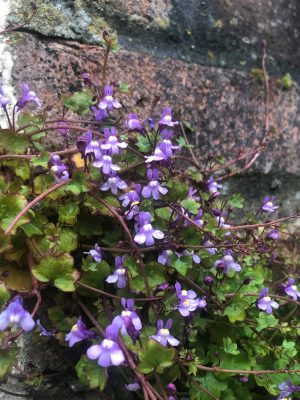Up until a week ago, I hadn’t the foggiest how to find a violet. I wasn’t even sure what they looked like! But having spent some time scouring the countryside (thankfully my friends don’t mind waiting whilst I examine random leaves and flowers while we walk) I’m seeing them everywhere.
What do Violets look like?
There are many types of violets you may encounter on an afternoon ramble. While they may vary in colour (most flowers are a soft purple, but there are edible varieties in white and yellow) they all share common features:

Violet's Dastardly Doppelgangers
Ivy Leaved Toadflax
This is not a poisonous plant.
Ivy Leaved Toadflax (or Kenilworth Ivy) has flowers that could easily be mistaken for violets. They have the same “two up, three down” petal pattern, but are much smaller in size. The flowers also have small yellow bumps (see picture) in the centre that set them apart.
The leaves are shaped a little like Ivy Leaves- another great way to tell the difference
Interestingly, the leaves are incredibly high in vitamin C and have been used in the past to treat scurvy!

Lesser Celandine
Yellow Celandine is a dangerous doppelganger that is easy to distinguish when in flower. Celandine has yellow flowers that resemble buttercups, but the same heart shaped leaves. These plants are toxic, so steer clear!

When and Where do Violets Grow?
In the UK, violets begin to blossom in late April and flower through till June.
I’ve had the most luck finding violets in woodlands and near water- along coastal paths and bordering streams. This is because they love moisture rich soils.
I’ve seen their purple heads peering out of verdant banks and creeping out from the cracks of moss covered walls. Keep your eyes at mid to low height when looking, and don’t be afraid to head down an alley or two.
They tend shy away from the sun- blooming mostly in full to partial shade.
How do you use them?
The blooms make beautiful garnishes and can be used to add vibrant colour to dishes and salads. You can use them to make violet syrup- a base for many violet cocktails (such as The Aviation) and sweet jellies.
We've shared a recipe for violet vinegar below- a delicious salad dressing that will turn a simple salad gourmet! It’s so easy, why not give it a go?
The green, heart shaped leaves are a delicious, nutritious alternative to spinach. Give them a go in a green salad, or blanch, boil or steam to add to your favourite dish.
Be sure to pick fresh, young leaves as older leaves can be tough and fibrous. It’s also best to avoid the stems, as they can cause a mild reaction in some people- a hot and uncomfortable sensation in the throat.
Remember, only forage the leaves when the flowers are in bloom, as they are almost identical to that of toxic doppelganger lesser celandine.
Curious Cures
The leaves are also edible, and high in vitamins A and C - half a cup of the leaves contains as much vitamin C as 4 oranges! They are also rich in the antioxidant beta-carotene and ascorbic acid. These leaves certainly pack a health punch!
Sweet violets have traditionally been used to cure a wide range of maladies, including insomnia, depression and the common cold. The leaves and flowers of this particular violet contain decongestants- perfect for getting a cough off your chest.
How Can You Start Using Violets?
We’re preserving violet flowers this week in the Foodie Revolution, with sugaring- a method as old-as-time.
Not in the foodie revolution? No need to miss your violet fix- why not whip up a cocktail or make some violet vinegar? It's vibrant purple colour will transform any salad dressing into a magical potion- perfect for getting the kids to eat their greens! Try the recipe below and let us know what you think.
We'd love to see what your up to- be sure to tag us in your foraging phots and cooking snaps!

[…] Their purple heads can be found peering out of verdant banks and creeping out from the cracks of moss covered walls. Keep your eyes at mid to low height when foraging, and don’t be afraid to head down an alley or two! For more helpful hints, take a look at my Violet Foraging Secrets to Success. […]